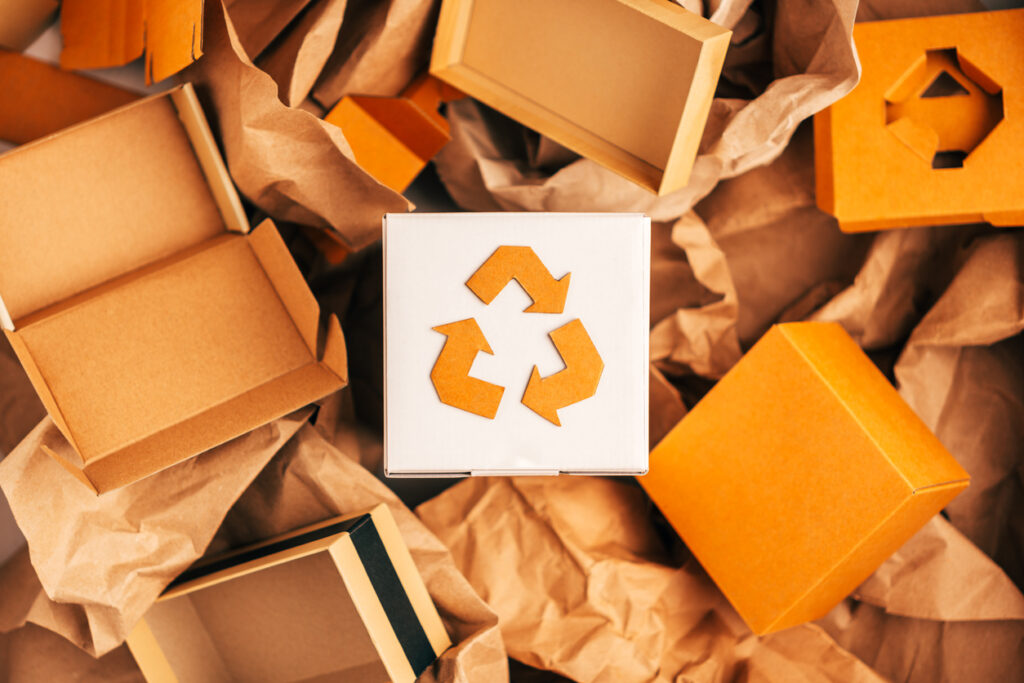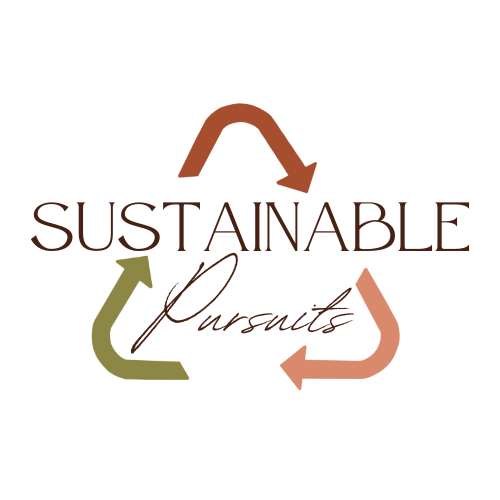As you may know, every month I try to do a plastic-free challenge to cut down on plastic waste from single-use plastics. But from the headline, you can probably guess that we’re going to be talking about about paper recycling in this article. So, why the focus on paper instead of just plastic?
Originally, I wanted to focus this month’s plastic-free challenge on office supplies. This led me to contemplate tape and labels, which then led me to contemplate packaging in general. So, I looked into what options there are to reduce waste from packaging materials. Since packaging materials typically consist of plastics and paper, this seemed like a good time to learn more about paper recycling as well.
Keeping Packaging Materials Out of the Landfill
One of the best ways to keep packaging materials out of the landfill is with recycling. Either by using boxes and mailing envelopes with recycled content, or making sure to recycle those items when you’re done with them.
While recycling is one of the sustainable options, it isn’t the only type of eco-packaging. In my previous article, I talked more about other types of eco-friendly packaging such as biodegradable materials and minimalist designs. But today, we’re going to focus on what we need to know about paper recycling and how it relates to packing materials.

What We Should Know About the Paper Recycling Process
In my case, a lot of the eco-friendly labelling claims started to make sense when I learned more about how paper is recycled. Things like ink, glue, plastics and other non-paper materials are usually removed by using water or chemicals during the recycling process. If these contaminates aren’t removed they will cause defects to the final product.
Here’s a brief definition for paper recycling – paper is recycled by mixing the used paper with water and chemicals. Then it’s chopped and heated to form a pulp (aka slurry). “It is then strained through screens, which removes plastic (especially from plastic-coated paper) that may still be in the mixture. In the next step the pulp is cleaned, de-inked (ink is removed), bleached, and mixed with water” (Wikipedia.org).
1. What Impacts the Paper Recycling Process?
- Mixed Paper: Quality of paper can vary, a newspaper is very different from a glossy magazine. Mixed paper can often contain different types of inks, adhesives, coatings, and even synthetic materials, making it harder to recycle.
- Contamination: If paper is contaminated with food, grease, or chemicals it cannot be processed in the same way as clean paper. This is because the oils interfere with the pulp during the recycling process.
- Ink and Coatings: Some paper contains ink, dyes, or coatings (such as wax or plastic layers). These materials often cannot be easily removed during the recycling process and can affect the quality of the recycled paper.
2. Recycling Still Requires Energy and Water Inputs to Create a Finished Product
- Energy-Intensive Process: Paper recycling requires significant energy to break down the paper, remove ink, and convert it back into pulp for new paper products. While it’s still less energy-intensive than creating paper from raw wood pulp, it’s not entirely without energy costs.
- Water Usage: The paper recycling process also uses large amounts of water to wash away inks, adhesives, and other contaminants. Some of this water can become polluted and require treatment before being returned to the environment. This is where eco-friendly inks, tapes, and labels can make a big difference.
3. Paper Recycling “wears out” the paper
- Fiber Degradation: Each time paper is recycled, the cellulose fibers in the paper break down a little more. After several rounds of recycling, the fibers become too short to be useful in making new paper products, reducing the quality of the recycled paper. This is why virgin fiber (paper made from trees) is still needed to maintain the quality of paper products.
4. The Environmental Benefits of Paper Recycling
- Reduces Deforestation: By using recycled paper, we reduce the need for virgin wood pulp, which helps preserve forests and reduces deforestation.
- Saves Energy: Recycling paper uses about 40% less energy than making paper from virgin wood, which can reduce greenhouse gas emissions associated with paper production.
- Reduces Landfill Waste: Recycling paper reduces the amount of waste sent to landfills, where it would otherwise take up space and release methane.
What can we – as consumers – do to make paper recycling more effective?
Right now, there are 2 key actions/habits we as consumers can do when it comes to paper recycling. One, is to reduce contaminations from getting into the paper recycling stream in the first place. The second, is to purchase packaging made from recycled products.
Why does it help to buy recycled paper products? This is where we get to speak with our dollars! If market demand for recycled paper is low, then it can be less economical for companies to recycle or used recycled content. If businesses don’t invest in recycled paper, it reduces the incentives for better recycling practices and infrastructure. So, if you want more products with recycled content, do what you can to support these products on the consumer end.
How do we reduce contaminates in the paper recycling stream? There’s actually quite a bit to this question. I only just learned about some of these contamination sources, so I wanted to cover it in more detail.
Contaminates in Paper Recycling – And What We Can Do About Them
As previously mentioned, there are several things that can effect and contaminate the paper recycling process. Those things are: food residue, grease, oil, inks, non-paper labels, adhesives, coatings, and plastic tape.
Food residue, grease, and chemicals
Since we’re focusing on packaging materials, I’ll just briefly address food residue, grease, and chemicals by saying PLEASE DON’T PUT THESE CONTAMINATES IN THE RECYCLING BIN! I know, it can be hard to resist but don’t do it!
However, the clean pieces can be torn off and put in the recycling bin, that’s fine. But the rest has to go in the trash.
What to do with mixed paper for paper recycling?
It’s important to sort the different types of paper. If your recycling center only takes certain types of paper (ex. cardboard, newspaper, office paper) don’t try to wish-cycle and throw in other types of paper products. It’s likely that the recycling center doesn’t have the resources to process papers that are saturated with ink or have some sort of coating.
Inks – How they effect paper recycling
Chemical Contamination: The inks used in printing papers are made from various chemicals, pigments, and solvents. When paper is recycled, these inks need to be removed so that the paper can be reprocessed. Inks, especially those with synthetic pigments or petroleum-based chemicals, can make it harder to produce clean, high-quality recycled paper.
De-inking Process: In the recycling process, paper is typically mixed with water and chemicals to create a slurry. The goal is to separate the paper fibers from the inks and other contaminants. If inks are difficult to remove, the process becomes less efficient, and the final recycled paper may not meet quality standards.
Impact on Paper Quality: If ink is not fully removed during recycling, it can affect the brightness and overall appearance of the recycled paper. Some types of ink, particularly those used in glossy magazines or colored packaging, are especially challenging to de-ink. This can result in a lower-quality recycled paper that may not be suitable for certain high-end paper products, forcing mills to rely on virgin fiber instead.
Eco-Friendly Ink Alternatives
Soy-based or Water-based Inks: Soy/vegetable-based inks and water-based inks are more environmentally friendly than traditional petroleum-based inks. These inks are easier to remove during the recycling process and contain fewer harmful chemicals.
Labels and Paper Recycling
Adhesives: Most packaging labels are glued on with adhesives that are difficult to remove during the recycling process. These adhesives can contaminate the pulp and hinder the production of high-quality recycled paper. The presence of these adhesives in the recycling stream means that paper mills often have to use extra chemicals and energy to break down the sticky residue.
Label Materials: Many labels are made from a mix of synthetic materials rather than just paper. These materials do not break down during the recycling process and can contaminate the pulp. For instance, foil-lined or plastic-coated labels can cause issues because they are not suitable for paper recycling.
How to Keep Labels from Contaminating Paper Recycling
- Labels should be removed before paper is recycled. This can be time-consuming but significantly improves the recycling process.
- Use Paper Labels with Water-Based Adhesives. Eco-friendly labels made from paper with water-based adhesives are easier to remove and process during recycling. Many companies are now adopting these to make their products more recyclable.
- Peelable Labels: Some labels are designed to peel off easily, leaving minimal residue, which helps reduce contamination in the recycling process.
How Tape can Contaminate Paper Recycling
Most standard tape, such as cellophane or polypropylene tape, is made from plastic. These types of tapes cannot be recycled with paper because they do not break down during the recycling process. Excessive amounts of packing tape can even clog recycling machinery.
Adhesive residues can stick to paper fibers and make it difficult to separate the fibers during the recycling process. Some types of tape leave a stronger adhesive residue than others, which can further complicate the de-inking and pulping process.
Reinforced tapes that have paper and plastic fibers (such as some shipping tapes) are particularly problematic. While the paper portion of the tape can technically be recycled, the plastic fibers present a challenge. This type of tape can cause issues at recycling facilities, as the different materials may not break down together, and the plastic portion can clog equipment or get mixed with other recyclables.
What Should We Do About Tape?
- Remove the tape! Just like with the labels, be sure to remove any plastic tape from cardboard or paper packaging before putting them in the recycling bin.
- Use paper or biodegradable tape.
- Kraft paper tape is made from paper and uses natural adhesives, which means it can be recycled with the cardboard or paper it’s sealing! Some paper tapes are water-activated (gummed paper tape), which makes them even more eco-friendly.
- Some newer tapes are made from biodegradable materials like PLA (polylactic acid) or other plant-based fibers, making them more suitable for recycling.
Conclusion
Paper recycling is a crucial part of reducing our environmental footprint, but it does come with challenges. While it’s not a perfect system, improving paper recycling processes, minimizing contamination, and supporting the demand for recycled paper can significantly help reduce waste, save energy, and conserve natural resources.
We as consumers can help the process by paying attention to the materials used in paper packaging such as ink, labels, and tape. Decreasing the contaminates in the recycling stream can significantly improve the efficiency of paper recycling. Reducing contaminates that end up in the recycling stream might seem like a small step, but it can lead to bigger environmental benefits.
So next time you’re choosing packaging materials, consider opting for sustainable paper products that are easy to recycle or made from recycled content. And when you receive packages, be sure they are ready for the next steps in their recycling journey. It’s all part of forming better habits to support a greener future! You’ve got this!

